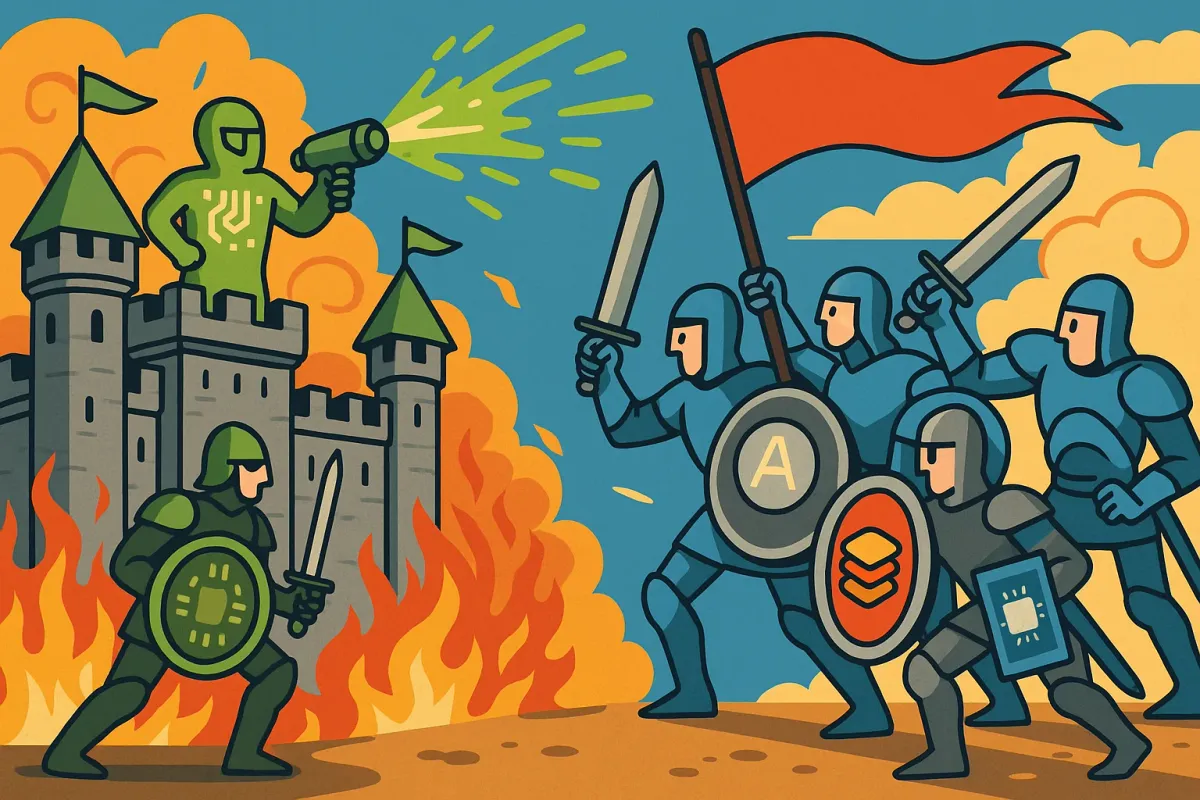The Vendor Wars: NVIDIA's Integrated Fortress vs. The Open Ecosystem Alliance
The battle for AI networking is a clash of philosophies. NVIDIA's integrated fortress offers turnkey performance at a proprietary cost. The Open Alliance bets on collaboration and open standards. Your choice is more than tech—it's a strategic vote.

Welcome back. We've journeyed from the high-level needs of the AI factory to the deep technical details of network protocols and the critical role of the DPU. Now, we zoom out to the world of business strategy, where the battle for the AI data center is being waged.
This is not just a competition between technologies like Ethernet and InfiniBand. It's a high-stakes strategic conflict between two fundamentally different philosophies for building the future. On one side, you have the incumbent champion, NVIDIA, with its tightly integrated, vertically-stacked fortress. On the other, you have a broad coalition of powerful companies—the Open Ecosystem Alliance—betting that collaboration and open standards will win the day.
Your choice of network is no longer just a technical decision; it's a vote for the kind of market you want to operate in for the next decade.
The Fortress: NVIDIA's End-to-End AI Empire
NVIDIA is in an astonishingly powerful position. As the dominant provider of the GPUs that are the engines of the AI revolution, they have leveraged that strength to build a complete, end-to-end, vertically integrated platform. They offer every single component of the AI data center stack:
- Compute: The world's leading GPUs (H100, B200, etc.).
- Scale-Up Fabric: The proprietary NVLink for ultra-fast communication between GPUs in a server.
- Scale-Out Fabric: High-performance InfiniBand and their own proprietary version of Ethernet.
- Endpoints: The BlueField DPU.
- Software: The ubiquitous CUDA programming model.
By controlling every piece of the puzzle, NVIDIA can co-optimize the entire system for maximum performance, delivering the record-breaking results you see in benchmarks. For a customer who wants a single throat to choke and the absolute highest turnkey performance, this is a compelling proposition.
To counter the market's demand for Ethernet, NVIDIA has developed a brilliant and strategic hedge: Spectrum-X. It's crucial to understand that this is not standard, open Ethernet. Spectrum-X is an engineered system that tightly couples NVIDIA's Spectrum switches with its BlueField DPUs and a suite of proprietary software.
This creates an "NVIDIA-flavored Ethernet" that delivers incredible performance but is designed to work best within the NVIDIA ecosystem. It's a strategy to give customers the "Ethernet" they ask for, while still keeping them securely inside NVIDIA's fortress walls.
The Alliance: A Bet on Open Collaboration
The only way for the rest of the industry to compete with NVIDIA's integrated stack is to work together. No single company can challenge them alone. This has given rise to the "Open AI" ecosystem, a powerful alliance of competitors all collaborating through the Ultra Ethernet Consortium.
Their shared bet is that customers, in the long run, will choose the flexibility, cost-efficiency, and supply chain diversity of an open, multi-vendor market over a proprietary, single-vendor solution.
Here are the key players in the alliance:
- Broadcom: The engine of the open ecosystem. As the dominant provider of merchant networking silicon, their Tomahawk and Jericho switch chips power the world's largest data centers. Their strategy is to provide the open, UEC-compliant silicon that allows everyone else to build competitive systems.
- Arista: The premier open systems builder. Arista takes Broadcom's powerful silicon and wraps it in their best-in-class hardware and their robust EOS software. They differentiate through superior system design and AI-driven management tools, offering a credible, enterprise-grade alternative to a single-vendor network.
- AMD & Intel: The full-stack challengers. Both AMD and Intel are building comprehensive portfolios to rival NVIDIA.
- AMD has its powerful Instinct GPUs, EPYC CPUs, and the world-class Pensando DPU, all tied together with its ROCm open-source software platform.
- Intel offers its ubiquitous Xeon CPUs, Gaudi AI accelerators, and its own IPUs, all supported by its oneAPI open programming model.
The vision of the alliance is powerful. A customer could, in theory, build a best-of-breed AI cluster using AMD GPUs, Intel IPUs, and Arista switches running on Broadcom silicon. The success of this entire vision rests squarely on the UEC's ability to deliver a robust and truly interoperable standard that makes this seamless plug-and-play a reality.
The battle lines are drawn. It's a classic strategic conflict: the integrated, high-performance, but proprietary fortress versus the flexible, cost-effective, but collaborative open alliance.



